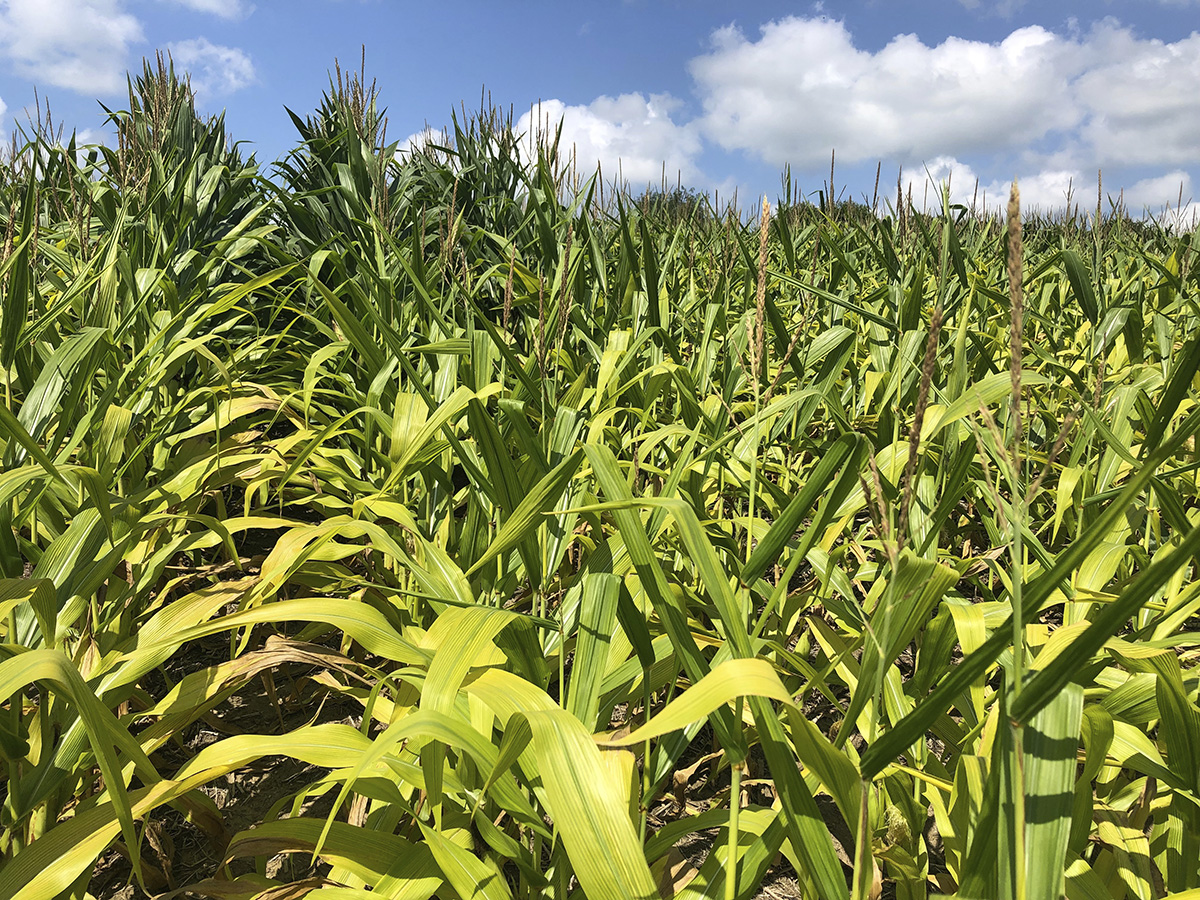
By Tyler Williams, Extension Educator, Lancaster County
Sulfur deficiency in corn is increasingly becoming a problem for growers. Sulfur (S) availability to crops during the growing season is a combination of soil, crop and environmental interactions. Sulfur is a macro-nutrient along with nitrogen (N), phosphorus (P), potassium (K), magnesium (Mg) and calcium (Ca) and is an essential building block in chlorophyll development and protein synthesis.
SULFUR AVAILABILITY AND USE
Crops will remove S from the soil in both the residue and the grain. Corn grain contains about 0.5 lbs of S for every 10 bushels of grain, and soybeans contain about 1.7 lbs of S per 10 bushels. Thus, if you raise 200 bu/ac corn and 60 bu/ac of soybeans in a rotation, you remove approximately 10 lb/ac of S from the field each year. This removal increases with increasing yields over time.
If sulfur fertilizer is not applied, the S must come from the soil or the atmosphere. Historically, significant amounts of S have been deposited on the soil from the atmosphere, but due to reductions in S emissions from power plants, the amount of S deposited has dropped, especially in the Midwest region.
According to the National Atmospheric Deposition Program, Eastern Nebraska received a total atmospheric deposition of about 2 lbs of S per acre in 2017, with higher amounts (6–8 lb S/ac) along the Missouri River. In 2000, amounts in Eastern Nebraska were closer to 6–8 lbs S/ac with locations near the power plants along the Missouri River close to 12–16+ lb S/ac.
This combination of increased removal with higher crop yields and decreased atmospheric deposition, increases the overall depletion of soil S.
IN-SEASON AVAILABILITY
Approximately 90% or more of plant available S comes from mineralization of organic matter. Organic sulfur can be mineralized to sulfate (SO4), which can be taken up by the crop. Every percent of organic matter in the top 6–8 inches of soil can produce about 100 lbs of S/ac, thus lower organic matter soil s produce less S. This mineralization process can be affected by soil temperature and moisture.
The spring of 2019 was cold and excessively wet, likely enhancing S deficiencies. Cold and excessively wet or dry conditions reduce the microbial activity required for mineralization, thus increasing S deficiency. Also, sulfate-S is a mobile nutrient, which behaves like nitrate, and can be lost through leaching from excess precipitation.
No-till, early planting and heavy residue may increase the occurrence of deficiencies. Corn and soybean residues are relatively low in S content, thus microbes breaking down the residue may use the inorganic S in the soil to aid in the process, temporarily making it unavailable to the crop, known as immobilization. This may cause S deficiencies to be more frequent early in the season with heavy residue. Sulfur availability can vary in the field and is likely lower in sandier soils, low organic matter areas and spots in the field with higher elevation.
TESTING FOR SULFUR
Visually, sulfur-deficient plants have an overall yellow appearance, similar to N deficiency; however, S is not as mobile in the plant as N and S deficiency symptoms will be seen on upper and lower portions of the plant. Corn leaves are pale yellow with the veins remaining green. The leaf striping may be caused by S deficiency and will appear similar to magnesium, manganese and zinc deficiency. Symptoms will appear inconsistent across the field, possibly due to variations in soil properties, but research has not fully documented the cause of variability or deficiency within fields.
If S deficiency is misdiagnosed as N deficiency, the application of more N may actually make the S deficiency worse. The best way to diagnose is by tissue sampling. Collect above-ground whole plants at V4 or the youngest leaf with fully formed collar after V5. If at tassel or later, collect ear leaf samples. Make sure to collect plants from suspected areas and plants from healthy-appearing areas to have a comparison.
Soil sampling may not adequately predict S deficiencies. Typical soil testing is done in the fall or spring, and SO4 is soluble and can be leached below the root zone by the time the crop needs it. Also, soil tests are often only taken to depths of 6–8 inches and may actually underestimate what is available to the crop below those depths. Common soil tests may not measure the organic S, which can be a significant portion of crop S uptake after mineralization. Soil tests can still be useful in tracking changes in soil S over time.
CORRECTING FOR SULFUR DEFICIENCY
Research sites in Iowa only showed yield response to S applications three times in the approximately 200 trials before 2005, indicating sufficient S amounts, but this began to change in the early 2000s. From 2006–2013, there has been approximately 110 S trials in Iowa, with corn yield response at 47% of sites.
Recommendations from UNL for sulfur are primarily for coarse-textured soils, which are not common in Eastern Nebraska. The recommendation from Iowa State for confirmed S deficiencies in corn, on fine-textured soils, is to apply approximately 15 lb S/ac. Sulfur fertilizer should be applied as close to crop need as possible to reduce the chance of losses.
There is still a lot of uncertainty about S deficiencies and fertilizer recommendations, so reach out to UNL specialists or contact your dealer or agronomist for fertilizer options.
Resources used in this article:
• Sulfur Deficiency. Purdue University Department of Agronomy, http://www.agry.purdue.edu/ext/corn/news/timeless/sulfurdeficiency.pdf
• Sulfur Management for Iowa Crop Production. Iowa State University, https://store.extension.iastate.edu/Product/CROP3072-pdf
• Nutrient Management Suggestions for Corn. University of Nebraska–Lincoln, http://extensionpublications.unl.edu/assets/pdf/ec117.pdf
• National Atmospheric Deposition Program, http://nadp.slh.wisc.edu/committees/tdep/tdepmaps